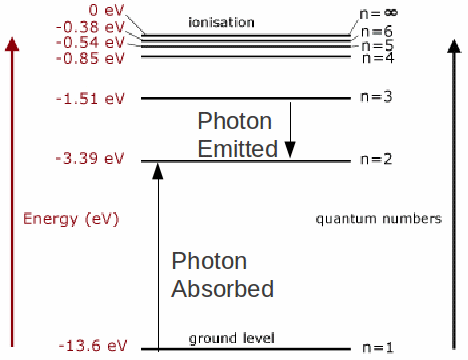In an atom, electrons occupy orbits, each with a particular energy. The orbits and energies are specific to each element. This energy is negative because the electron and nucleus are oppositely charged, so attract each other and energy must be given to the electron to enable it to escape the atom. The energy levels for the electron in hydrogen are shown below. They obey the simple formula![]() No such simple expressions exists for heavier atoms.
No such simple expressions exists for heavier atoms.

Electrons may move between energy levels by absorbing or emitting an amount of energy equal to the difference between those levels. The energy is absorbed or emitted as photons, packets of electromagnetic energy. The energy of a photon is![]() where
where![]() is Planck's constant equal to
is Planck's constant equal to![]() and
and![]() is the frequency of the photon, so for a transition between levels
is the frequency of the photon, so for a transition between levels![]() and
and![]() with
with![]() If the electron is given enough energy it may escape the atom completely, leaving it ionised.
If the electron is given enough energy it may escape the atom completely, leaving it ionised.
For example for the electron to be excited from the ground state with n=1 to the n=2 level
![]()
